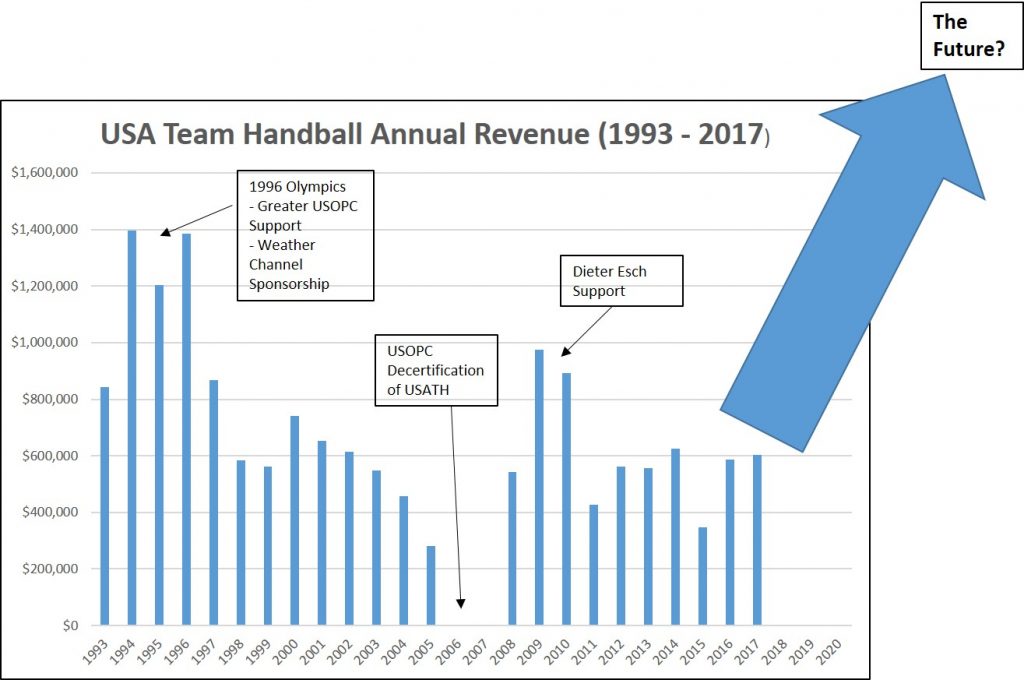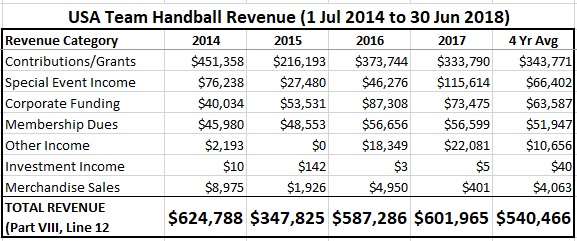
The previous parts of this series have focused on our current athlete and club demographics. This part of the series will focus on USA Team Handball’s current finances.
Big Picture
As you might recall from the introduction to this series I am addressing possible futures for USA Team Handball by first methodically capturing, “What we have.” I have covered quite a bit of ground, but haven’t focused on the lack of money and resources that pretty much underlie most of team handball’s small footprint and presence in the U.S.
It may be true that “Money isn’t everything”, but I think we can also agree that, it’s still something. And, that without money it’s very difficult to move forward with new projects and initiatives. As one long time handball follower put it to me succinctly:
“If there’s more money, there are more choices. But, if there’s no money, there are no choices.”
While, historically there has usually been “some money” it’s been pretty limited with the exception (to varying degrees) of support to national teams that have qualified for the Olympics. In recent years, the cupboard has been really bare. Fortunately, there are a number of developments that should help improve USA Team Handball’s financial situation. These developments include the 2028 LA Olympics, IOC pressure on the IHF to develop handball globally, and European pro leagues/clubs seeking to develop a U.S. market. Yes, after years of shrugging, Europeans are finally starting to realize the potential of a U.S. market and seem willing to do some things to make it happen. All told, this confluence of events could be a real game changer.
Yes, long time followers that accuse me of being an eternal pessimist I am truly optimistic that our financial picture will change.
But, while these numbers should change in the not too distant future, it’s still a worthwhile exercise to assess where we are starting from. Further, it’s important to also characterize the different sources of revenue. Where the revenue is coming from and where there are opportunities to improve revenue generation.
Publicly Available Data
To assess USA the current financial situation I have reviewed USA Team Handball’s publicly available financial data. As a 501(c)(3) non-profit, USA Team Handball is required to file an Internal Revenue Service (IRS) Form 990 every year. Additionally, an audited financial statement is prepared on a yearly basis and both the annual audits and Form 990s are available on the USA Team Handball website. While great information this data, however, has its limitations. In particular, it’s top level data, so while it might be really interesting to break down revenue sources and expenses in greater deal, that information is not available. Additionally, the forms are typically posted around one year after the accounting period in question. So, if you are looking at a hot off the press Form 990 you will be reviewing data that is actually 1-2 years old. And, if it’s been awhile since the Form 990 has been posted you could be reviewing data that is 2-3 years old.
The data below comprises the last four available Form 990s, covering the period from July 30, 2014 to June 30, 2018, so the data that is from 1.5 to 5.5 years old. I have heard that the IHF and USOC have kicked in some grant funding already, but it’s not clear how much and for how long. While this data doesn’t include those plus-ups it does provide a good baseline.
USA Team Handball Financial Data: Link
Total Revenue

USA Team Handball’s average total annual revenue has been roughly $540K. For a U.S. Sport National Governing Body (NGB) this is a paltry amount that significantly limits what can be done. Compared to several other team sport NGBs it is an order of magnitude smaller. There’s a reason why for several years USA Team Handball has been pretty much a staff of one, plus coaches and a part team media specialist. Heck, in some years it’s not even clear whether the coaches have actually been paid. I have also heard rumors that at times there have been cash flow issues resulting even the CEO not being paid. It should therefore come as no great surprise that many national team trips for competition have been partly self-funded by the players participating.
So why has the revenue been so lacking? Let’s take a closer look at several sub-components of the top line number.
Grants and Contributions

Historically, an annual grant from the USOPC has been the primary source of revenue for USA Team Handball. For the 4 most recent years of available data the USOPC has provided around $225K/year. As I’ve highlighted previously the annual USOPC grant used to be substantially more but has decreased over the years for several reasons. First, following the 1996 Olympics the USOPC began more closely tying financial support to medaling opportunities. With the U.S. being very unlikely to medal grant funding decreased. Secondly, the U.S. has failed to qualify for the Olympics since 1996 meaning there was no need to support national teams so that a “respectable” performance in the Olympic spotlight could be had. Finally, there have been general concerns with the management and performance of USA Team Handball. The 2005 decertification of USA Team Handball is a prime example of those concerns.
With the 2028 Olympics now on the horizon and with greater engagement from the IHF, USOPC concerns seem to have been lifted. Reportedly the USOPC is now providing some additional grant funding that is more in line with what other minor sport NGBs are provided.
The U.S. Team Handball Foundation which was established with left over funds from the 1984 Olympic Game has also been a consistent source of revenue support, albeit on a smaller scale. For the most recent four years they have provided roughly $34K/year often in support of national team competition.
The IHF did not provide any grant support in the posted four years, but reportedly they are now providing some grant funding to support college development efforts. How much funding and for how long, however, has not been officially reported. It would certainly be interesting to know, but we probably won’t officially know until the 2019 Form 990 is released in spring 2021.
Contributions are charitable donations that USA Team Handball receives from individuals and have averaged $88K for the past 4 years. Considering the small base of supporters USA Team Handball has to work with this is actually a fairly decent number compared to other NGBs with much larger membership bases to draw from.
Corporate Sponsorship

Corporate sponsorship is roughly $64K/year and this is, as one might expect, substantially lower than other NGBs. In short, “what we have” is pretty much next to nothing. There has long been an outcry that this was a direct result of management and salesmanship incompetency. However, as I pointed out in this 2012 commentary the reality is that sponsors are not in the business of charity and they want to see return on their sponsorship investment. With a very small membership base and no TV exposure it has been very difficult to make a strong business case in support of USA Team Handball sponsorship. There essentially has been no product to credibly sell to sponsors. So, in other words I would argue that it was more of a product issue than it was a salesmanship issue.
However, with some investment from the USOPC and IHF this could be changing and we could actually have some products (e.g. a collegiate club championship) on the foreseeable horizon worthy of sponsorship. Add in the promise of the 2028 Olympics in Los Angeles and it’s becoming more possible to sell the future of USA Team Handball.
Further some personal relationships with a key handball proponent could make a difference. In October, USA Team Handball and the IHF met with Verizon CEO, Hans Vestberg, in New York. (IHF Writeup: Link) Vestberg is a former handball player and the former President of the Swedish Handball Federation and Swedish Olympic Committee, so he personally has an affinity for handball. Verizon is also one of the largest companies in the U.S. (16th on the Fortune 500 list) and already has major sport sponsorships with the NFL, NHL and NASCAR. The NFL deal alone is reportedly for $500M/year so one can easily envision some sort of deal (on a smaller scale) for USA Team Handball being announced in the near future.
So right now, sponsorship revenue is paltry. But, this could be changing very soon. For how much and for how long, again are the big questions.
Next up: The assessment of current finances continues with a closer look at events and memberships.